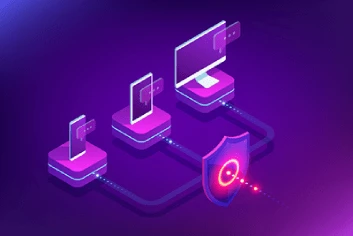The EDR Workflow: From Detection to Remediation
The EDR workflow is a structured process that enables organizations to detect, analyze, and respond to cyber threats in real time. It consists of several stages, each playing a critical role in ensuring endpoint security. The process begins with continuous monitoring, where EDR solutions collect and analyze data from endpoints, including process executions, file changes, network activity, and system behaviors. This constant surveillance allows for the early detection of anomalies that may indicate a cyber threat.
Once data is gathered, EDR systems use advanced threat detection mechanisms to identify suspicious activities. These mechanisms include behavioral analysis, machine learning, and threat intelligence feeds. Unlike traditional security tools that rely solely on signature-based detection, EDR solutions analyze patterns and behaviors to detect previously unknown threats, including zero-day attacks and fileless malware. If a potential threat is detected, an alert is generated and sent to security teams for further investigation.
The next stage in the workflow is forensic analysis. EDR platforms provide security analysts with deep insights into the nature of the attack, including the origin, methods used, and the extent of the impact. Security teams can access detailed logs, timelines, and attack chain visualizations to understand how the threat infiltrated the system and spread across endpoints. This analysis helps determine whether the attack was an isolated event or part of a larger coordinated cyberattack.
Once the nature of the threat is understood, the remediation process begins. EDR solutions offer multiple response options, including automatic threat containment, isolation of infected endpoints, and blocking of malicious processes. In cases where human intervention is required, security teams can manually remove threats, roll back compromised files, and apply security patches to prevent future incidents. Some advanced EDR solutions also leverage AI-driven automation to speed up response times and minimize the need for manual intervention.
After remediation, the final step involves continuous improvement and learning. EDR solutions update their threat detection algorithms based on newly discovered threats and attack patterns. Organizations use post-incident reports to refine their security policies, improve endpoint defenses, and train employees on emerging threats. By continuously adapting to the evolving cyber threat landscape, EDR ensures organizations remain resilient against advanced attacks.
The EDR workflow is essential for modern cybersecurity strategies, offering real-time detection, rapid response, and in-depth analysis of cyber threats. Unlike traditional antivirus or firewall-based security, EDR provides proactive protection that evolves with emerging threats, making it a crucial component of any organization’s security framework.
EDR vs Traditional Antivirus: What’s the Difference?
Traditional antivirus (AV) and Endpoint Detection and Response (EDR) are both designed to protect systems from cyber threats, but they operate in fundamentally different ways. Antivirus solutions have been a staple of cybersecurity for decades, primarily focusing on detecting and removing known malware based on predefined signatures. In contrast, EDR takes a more advanced approach, providing real-time monitoring, behavioral analysis, and threat response capabilities to detect and mitigate both known and unknown threats.
One of the key differences between traditional antivirus and EDR is their detection methodology. Antivirus solutions rely on signature-based detection, meaning they compare files against a database of known malware signatures. While this approach is effective for detecting previously identified threats, it struggles against zero-day attacks, fileless malware, and advanced persistent threats (APTs) that have no existing signature. EDR, on the other hand, uses behavioral analytics and machine learning to identify suspicious activities. By analyzing patterns of behavior rather than relying solely on signatures, EDR can detect emerging threats that evade traditional antivirus defenses.
Another major distinction is in the scope of monitoring. Traditional antivirus typically scans files at scheduled intervals or upon execution, identifying threats based on signature or heuristic analysis. This means that if a threat is not immediately recognized, it can operate undetected until the next scan. EDR, however, continuously monitors all endpoint activity in real time, tracking user behaviors, process executions, file modifications, and network connections. This real-time monitoring ensures that even stealthy, sophisticated attacks can be identified and stopped before causing damage.
Response capabilities also set EDR apart from traditional antivirus. Antivirus solutions generally take a reactive approach by quarantining or deleting detected threats after they have already infiltrated the system. EDR solutions, in contrast, provide proactive incident response features, such as isolating compromised endpoints, rolling back malicious changes, and providing forensic analysis to understand attack vectors. These capabilities allow organizations to contain threats quickly and prevent further spread within the network.
Another critical difference is the level of visibility and control offered by each solution. Traditional antivirus provides limited insights into security incidents, often presenting basic logs of detected threats without context. EDR, however, offers detailed forensic data, including attack timelines, affected endpoints, and methods of intrusion. This information empowers security teams to investigate and respond to threats more effectively, reducing the overall impact of cyberattacks.
While traditional antivirus solutions remain useful for basic malware protection, they are no longer sufficient on their own in today’s evolving threat landscape. Cybercriminals are constantly developing new attack techniques that evade signature-based detection, making behavioral analysis and real-time response crucial components of modern cybersecurity strategies. EDR provides the advanced capabilities needed to detect and mitigate sophisticated threats, making it a necessary complement—or even a replacement—for traditional antivirus in enterprise environments.
Implementing EDR: What Organizations Need to Know
Implementing an Endpoint Detection and Response (EDR) solution is a critical step for organizations looking to enhance their cybersecurity posture. Unlike traditional security tools that focus on reactive protection, EDR provides real-time monitoring, threat detection, and automated response capabilities. However, successful deployment requires careful planning and consideration of several key factors to ensure optimal performance and effectiveness.
One of the first steps in implementing EDR is choosing the right solution. Organizations need to evaluate their security requirements, infrastructure complexity, and the types of threats they face. Some EDR solutions offer built-in AI-driven threat detection, while others focus on forensic analysis and manual threat hunting. It’s important to select a solution that aligns with the organization’s security strategy, integrates with existing security tools, and provides the necessary level of automation and visibility.
Integration with the existing security stack is another crucial consideration. EDR should seamlessly work alongside other security solutions such as firewalls, Security Information and Event Management (SIEM) systems, and cloud security platforms. Proper integration ensures that threat data is correlated across multiple sources, providing a comprehensive view of potential attacks. Organizations should also assess whether the EDR platform supports API integrations to enhance threat intelligence sharing and automate responses.
Deployment strategies play a significant role in the success of an EDR implementation. Organizations can choose between on-premises, cloud-based, or hybrid deployment models depending on their infrastructure and security needs. Cloud-based EDR solutions offer greater scalability and flexibility, making them ideal for organizations with remote workforces and multi-cloud environments. On-premises solutions, on the other hand, provide greater control over data storage and compliance but require more internal resources for maintenance and management.
Once deployed, configuring EDR policies and rules is essential for maximizing its effectiveness. Organizations should define baseline behaviors for endpoints and establish automated response mechanisms for different threat scenarios. Proper configuration ensures that the EDR solution can quickly detect and contain threats without generating excessive false positives that could overwhelm security teams.
Another key aspect of EDR implementation is training security personnel. While many EDR platforms offer automation, human expertise is still required for incident investigation, threat hunting, and fine-tuning security policies. Providing security teams with hands-on training and access to EDR analytics dashboards helps them respond more effectively to threats and leverage the full capabilities of the solution.
Continuous monitoring and optimization are necessary for maintaining the effectiveness of EDR over time. Organizations should conduct regular security assessments, update detection rules based on emerging threats, and ensure that EDR logs are properly analyzed for threat intelligence insights. Additionally, organizations should establish an incident response plan that incorporates EDR data for faster mitigation and recovery in the event of a security breach.
EDR implementation is not just about deploying technology—it requires a comprehensive approach that includes selecting the right solution, integrating with existing security tools, configuring policies, training personnel, and continuously optimizing detection and response capabilities. When properly implemented, EDR significantly strengthens an organization’s ability to detect, analyze, and respond to cyber threats in real time, providing a critical layer of defense against modern cyberattacks.






